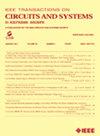基于近似系统的低成本有效的木马缓解技术
IF 4.9
2区 工程技术
Q2 ENGINEERING, ELECTRICAL & ELECTRONIC
IEEE Transactions on Circuits and Systems II: Express Briefs
Pub Date : 2025-01-31
DOI:10.1109/TCSII.2025.3537499
引用次数: 0
摘要
近似计算(Approximate Computing, AC)是一种很有前途的计算范式,它在容错应用程序中提供效率和速度,同时保持可接受的准确性。然而,大多数现有的交流设计都容易受到硬件木马(Hardware Trojan, HT)攻击。此外,现有的高温缓解技术是为精确系统设计的,由于近似系统的架构差异,这些传统的缓解技术在交流环境下使用时效果有限。因此,本简报提出了两种新方法,称为部分比较(PC)和混合比较(HC),有效地缓解了近似系统中的高温,同时实现了30%和55%的面积和功率效率改善。与现有最先进的技术相比。PC关注的是lsdb,而HC同时考虑lsdb和msb的HT屏蔽。通过图像处理的实际案例研究验证了所提出技术的有效性;三个不同ht的ip分别以33dB和0.92的PSNR和SSIM成功掩码。总之,本研究提供了实用的解决方案,以提高近似系统的安全性和可靠性,并获得最佳的性能效益。本文章由计算机程序翻译,如有差异,请以英文原文为准。
Low-Cost Yet Effective Trojan Mitigation Techniques for Approximate Systems
Approximate Computing (AC) is a promising computing paradigm that provides efficiency and speed while maintaining acceptable accuracy in error-tolerant applications. However, most of the existing AC designs are prone to Hardware Trojan (HT) attacks. Moreover, the existing HT mitigation techniques have been designed for exact systems and due to the architectural differences in the approximate systems, these conventional mitigation techniques have limited efficacy when used in the context of AC. Therefore, this brief presents two novel methods, named Partial Comparison (PC) and Hybrid Comparison (HC), that effectively mitigate HTs in approximate systems while achieving a 30% and 55% improvement in the area and the power efficiency, compared to the existing state-of-the-art technique. PC focuses on LSBs while HC considers both LSBs and MSBs for HT masking. The effectiveness of proposed techniques is validated through a practical case study of image processing; three IPs with different HTs are successfully masked with a PSNR and SSIM of 33dB and 0.92 respectively. In conclusion, this research provides practical solution to enhance security and reliability of approximate systems with optimal performance benefits.
求助全文
通过发布文献求助,成功后即可免费获取论文全文。
去求助
来源期刊
CiteScore
7.90
自引率
20.50%
发文量
883
审稿时长
3.0 months
期刊介绍:
TCAS II publishes brief papers in the field specified by the theory, analysis, design, and practical implementations of circuits, and the application of circuit techniques to systems and to signal processing. Included is the whole spectrum from basic scientific theory to industrial applications. The field of interest covered includes:
Circuits: Analog, Digital and Mixed Signal Circuits and Systems
Nonlinear Circuits and Systems, Integrated Sensors, MEMS and Systems on Chip, Nanoscale Circuits and Systems, Optoelectronic
Circuits and Systems, Power Electronics and Systems
Software for Analog-and-Logic Circuits and Systems
Control aspects of Circuits and Systems.

 求助内容:
求助内容: 应助结果提醒方式:
应助结果提醒方式:


